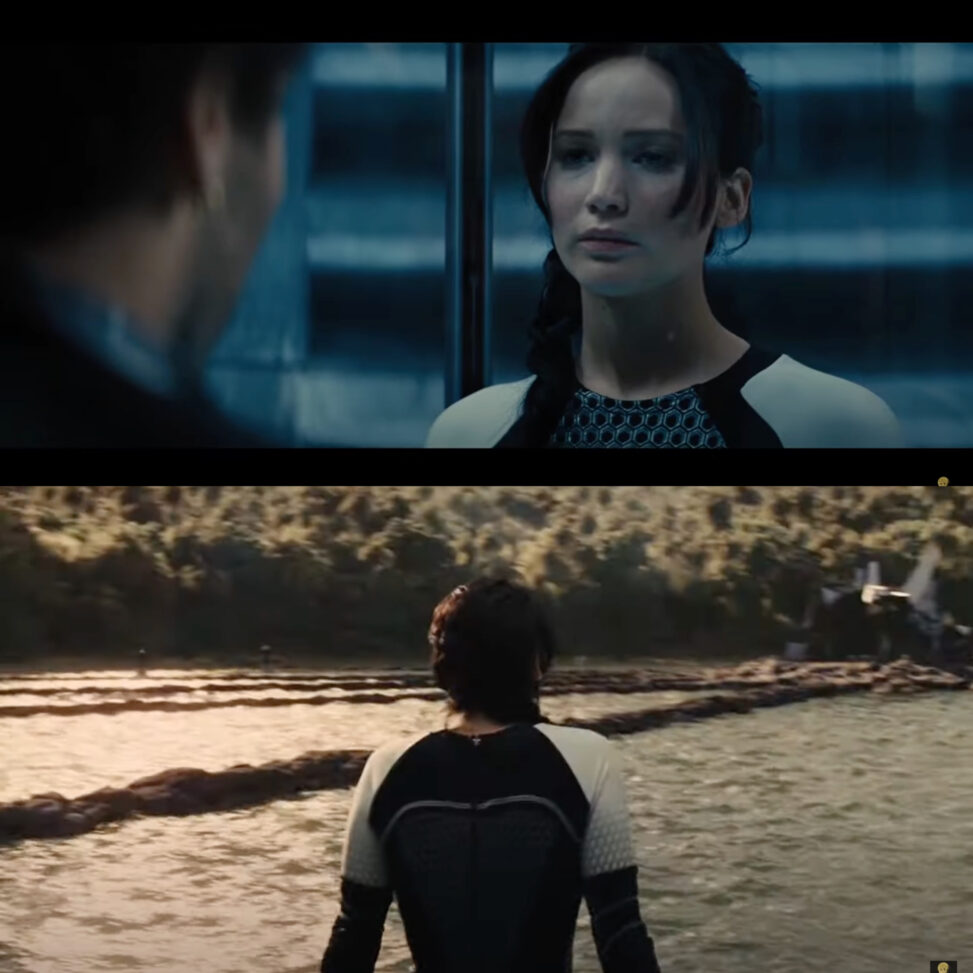The Hunger Games film series, directed by Francis Lawrence and Gary Ross is an onscreen adaptation of Suzanne Collins book trilogy. The second book of the series is titled Catching Fire, and the film adaptation hit theatres in 2013. Catching Fire grossed $424,668,047 domestic and $865,011,746 world-wide as stated on Box Office Mojo. The film follows protagonist, Katniss Everdeen who is the winner of the 74th hunger games. However, despite what is promised to all winners, she is abruptly thrown back into the games and must compete in a new arena, where she must fight to protect herself and the people she loves. The film uses different aspects of mies-en-scene as well as an aspect ratio change to drive home significant themes and ideas.
The film takes audiences though multiple fight scenes as well as different scenic shots. One shot that stands out to me is when Katniss sees the new arena for the first time. The scene starts out in a dark room where Katniss meets with her stylist Cinna, moments before being forced back into the arena. Katniss and Cinna are both dressed in dull grey and black clothing. After an emotional goodbye, Katniss steps into the tube that will transport her up to the arena and it closes around her. Suddenly guards appear in the room and attack Cinna, ultimately killing him while Katniss can do nothing but scream and cy. The music is intense and grows more intense as the scene progresses, and the camera pans around Katniss in a circular motion. This helps to emphasise the disorientation felt by Katniss in the moment. It adds to audience participation as it sends the viewer into a state of disorientation as well, making it seem like they are in the arena too. The addition of loud synth in the background make for a perfect illustration for what Katniss was feeling in that moment. The new arena is revealed to be a beach themed space with lots of trees and as large body of water.
Setting plays a huge part in these scenes as they help to contrast what’s happening and puts emphasis on the urgency of what’s happening at that point in the film. Setting is one of the visual elements characterized within mise-en-scene. This is a French term meaning “place on stage”. Another element of mise-en-scene utilized is lighting. The scene where Katniss and Cinna are talking is rather dark as the room is all coloured in grey metallics. The dark room sets the tone that the scene is taking place in a serious setting as well as points towards the fact that something bad is about to come. Upon entering the arena, the scenery changes immediately. Viewers are hit with bright and intense colours that heavily contrast the previous scene. The drastic change in scenery puts emphasis on the fast paced nature of the games
The most significant part of these back-to-back scenes is the fact that the film changes its aspect ratio as Katniss emerges into the arena. This is the tuning point of the film and when it switches from 2.39:1 to IMAX . IMAX was first introduced back to Expo 67 in Montreal, Québec. In 2001 movies began to undergo transformations to have them remastered into the IMAX format, the first being Apollo 13 . The change in aspect ratio signifies a whole new chapter in the film, it seemingly changes the tone too. It occurs when Katniss initially enters the arena, and it is almost as if it’s the realization setting in for her.
The Hunger Games is a classic dystopian film where a heroine stands out amongst her community and is thrust into a fast-paced environment different to anything she’s ever known. While the whole concept of the films and books is far from a possibility it has provided young girls with a hero to look up to.
Katniss can serve as a role model to young girls as she is brave, strong, stands up for what she believes in, and traditional romance isn’t the focal point of her story. This allows young girls to look up to someone who isn’t as different from them as they may initially think.
Catching Fire utilizes different elements encapsulated in mies-en-scene as well as an interesting editing choice to make audiences feel different emotions and emphasize different themes in the movie.
Bibliography
Lathrop, Gail, and David O Sutton. Elements of mise-en-scene. Accessed March 25, 2024. https://blogs.baruch.cuny.edu/latinxscreens/files/2021/02/Elements-of-mise-en-scene-G.-Lathrop-and-D.-Sutton.pdf.
Sheridan, Gabrielle. Inside IMAX: What Makes It “The World’s Most Innovative Movie-Going Experience”. 4-7


Jennifer
As a person who has watch this movie a lot of times, I do agree with their assessment of it. They did good in explaining how different camera movements show the emotions that the character is feeling, and also how the sound also helps with showing the feelings and emotions of the characters. They also did good at explaining how the camera movements and the sounds play a part in getting the audience to feel what the characters are feeling. They were able to use mise en scene to explain everything. They explain how the lighting changed and the importance of lighting for the specific parts of the scene. Then they were able to explain how the different colours of the parts of the scene and the clothing helped with the feelings and emotions of the scene. They had some scholarly sources in the bibliography, but nothing was physically cited in the analysis. To me I think that most of it was them taking the sources and then using them as an idea to write with. Yes, their image is an accurate illustration of the description of the scene that they gave.